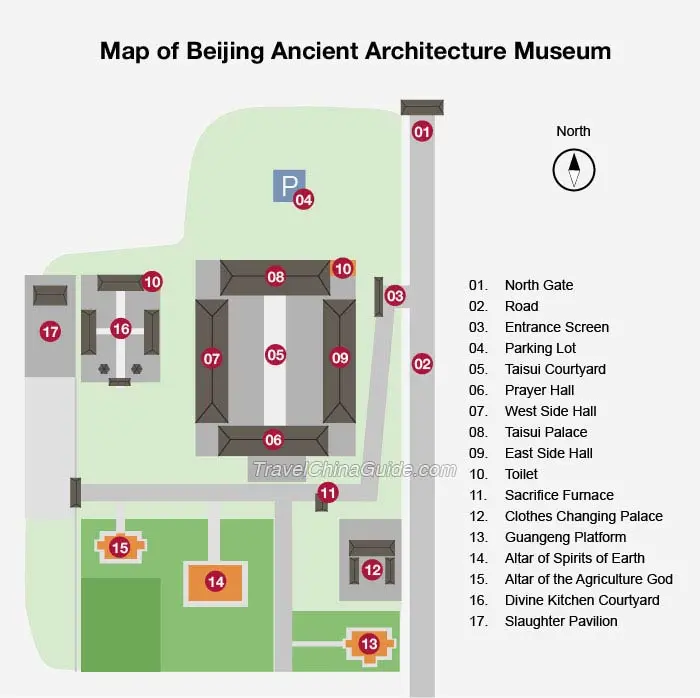Beijing Ancient Architecture Museum
Beijing Ancient Architecture Museum, located at No. 21 Dongjing Road in Xicheng District, is established in the Temple of Agriculture (Xiannongtan Temple), between Temple of Heaven and Taoranting Park, which are both renowned scenic spots in Beijing. It is the first topic museum in China collecting, studying and exhibiting items of ancient Chinese architecture. The exhibitions are mainly displayed in Taisui Palace, Prayer Hall, and Side Halls. The two major exhibitions in this museum are Demonstration of Chinese Ancient Architecture, and History and Culture of Temple of Agriculture.
Layout
Once you step into the Ancient Architecture Museum, Taisui Courtyard is right in front of you. It is the largest complex in the museum, covering an area of 9,124 square yards (7628.5 square meters). This courtyard consists of Taisui Palace, Prayer Hall and two Side Halls. It was a place for emperors and officials to worship Taisui God in the Ming and Qing Dynasties (1368 – 1911 AD).
To the south, there lie Clothes Changing Palace (Jufu Palace), Cultivating Viewing Platform (Guangeng Platform), and Emperor's Farmland. The emperor would change his clothes in Jufu Palace and then work on his farmland at the cultivating worship ritual. Guangeng Platform gave the emperor a place to view officials performing the ritual.
Walking to the west, it's Altar of Spirits of Earth. The altar is used to worship gods who are in charge of the weather, in order to pray for a good harvest.
Keep going, you will see Altar of Agriculture God on the south side. In the Ming and Qing Dynasties, emperors would worship the god of cultivation here. On the north side, it's a courtyard to prepare sacrifices and store memorial tablets of the farming god.
 |
| Map of Beijing Ancient Architecture Museum |
Demonstration of Chinese Ancient Architecture
Demonstration of Chinese Ancient Architecture is displayed in Taisui Courtyard. This exhibition shows the changes of Chinese architecture style from the original thatched huts to the rigorous and magnificent palace constructions with rich amount of pictures and exquisite models. The exhibition contains five parts: Development of Chinese Ancient Architecture, Skills Used in Construction, Reproduction of the Sacrifices Scene towards Taisui God, Development of Chinese Ancient Cities, and Construction Types of Chinese Ancient Architecture.
History and Culture of Temple of Agriculture
This exhibition includes three parts. The first part is about the history and construction style of Temple of Agriculture. Then, you will know the process, sacrificial vessels and institutions about sacrifice ritual in the second part. In ancient China, agriculture was the main industry, and on the other hand, people were in awe of the god. So worshipping the god of agriculture has been listed in the institution since the Han Dynasty (202BC – 220 AD). The third part will explain the worshipping culture to visitors.
How to get to Beijing Ancient Architecture Museum
Beijing Bus / Subway Search
| Admission Fee | Entrance Ticket | CNY 15 *First 200 visitors on every Wednesday are free to enter. |
|---|---|---|
| Audio Guide | CNY 10 (Deposit: CNY 100) | |
| Opening Hours | Tuesday to Sunday: 9:00 – 17:00 (Ticketing stops at 16:30.) *Closed on every Monday, New Year's Day, Chinese New Year's Eve and Chinese New Year (Spring Festival). | |